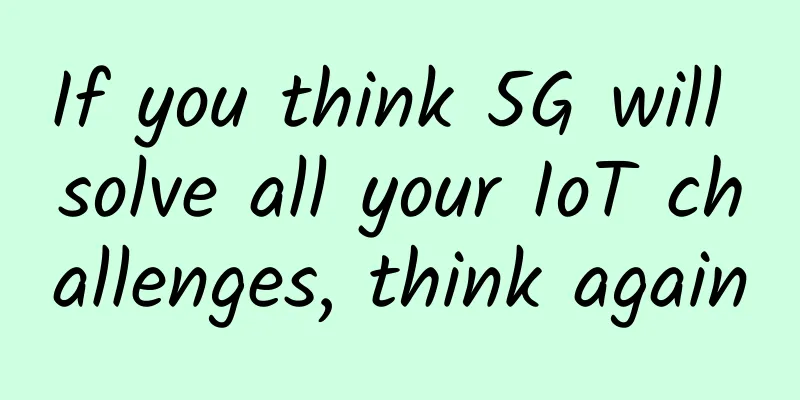If you think 5G will solve all your IoT challenges, think again

|
5G stands for the next generation of mobile communications technology. The GSMA predicts that by 2025, about half of all mobile connections in the United States will be on 5G networks. With significantly enhanced bandwidth capabilities, 5G speeds are expected to be 100 times faster than 4G and are seen as a game-changer that will drive enhanced mobile broadband services and widespread adoption of the Internet of Things, especially mission-critical use cases. It is estimated that by 2020, 20 billion devices will be connected to the Internet.
But even as mobile operators around the world move to 5G, the road to IoT will not be without its bumps. As network infrastructure providers of all types strive to keep pace with mobile operators’ investments while protecting their own profitability, we expect some inevitable speed bumps to emerge, especially when it comes to ensuring device performance — low latency, fast connections, and exceptional reliability. Here’s why: Trying to build Rome in a day: Any time a big project is undertaken in a relatively short period of time, the potential for errors and missteps tends to increase. According to McKinsey, mobile operators’ network-related capital expenditures are expected to grow 60% from 2020 to 2025. Throughput, scalability, and reliability will need to increase many times over current levels to support the surge in users, connected devices, and traffic that 5G will bring. Inevitably, this will have a trickle-down effect on external infrastructure service providers such as cloud, CNS and DNS. The entire delivery chain needs to be strengthened to keep up with the pace of 5G while protecting the economic interests of individual suppliers. A few vendors who are optimistic about the prospects will rush in quickly, confident that their investment will pay off dramatically in just a few years. Among these companies, we are likely to see growth in scale, scope, and speed never seen before to support the expected eightfold increase in global mobile data traffic. Other "wait and see" approaches: Other service providers will take a more cautious approach, such as setting certain utilization thresholds and making additional investments once they are reached or exceeded. In the meantime, these service providers will reconfigure existing resources, deploy virtualization, and other methods to maximize existing capacity. While both approaches have their own pros and cons, one thing they have in common is a trend toward increasing performance gains. For the more optimistic vendors, we have seen years of rapid expansion lead to multiple instances of missteps and errors, some of which appear to be completely random. For example, the recently publicized Google Border Gateway Protocol hijack, in which Google-targeted traffic from around the world was inadvertently sent to Russia and China, was ultimately traced to a mistake Google made when expanding its local presence through peering relationships with Nigerian ISPs. While more cautious vendors focus on maintaining profitability, they could run into operational difficulties as 5G traffic rapidly increases. In addition, while technologies such as virtualization can provide some short-term flexibility, constantly changing partitions and instances can make it more difficult to quickly locate growing hotspots. Compare a fire hose to a drinking straw: 5G is a last-mile mobile network connection technology. While it will connect a large number of users and IoT devices, the increase in speed and throughput only applies to the journey of the data packets. Even if two communicating devices are connected to mobile broadband via 5G, if the wider network path between them is limited or has vulnerabilities, the speed or reliability of information delivery will inevitably be affected, regardless of the speed of the device's last-mile connection. 5G will greatly increase the use of mobile video and media, as well as the adoption of the Internet of Things around the world. We can expect that external infrastructure providers will take some inadvertent and clumsy measures in response to the huge growth demand, which may cause occasional service delays or unreliability. While this may be tolerable for some consumer-oriented applications and devices, it is not enough for mission-critical IoT applications such as connected cars, connected cities, medical devices, etc. Overall, we expect to go through a few years of awkward adolescence and growing pains as the broader network infrastructure catches up to 5G. To guard against performance risks, IoT users and device manufacturers (especially those that are mission-critical) need to be extra vigilant. The challenge ahead is to harness and analyze the vast amounts of device performance data and proactively identify the growing hotspots in the vast depth and complexity of the infrastructure. |
<<: Eight SEO optimization tools you must master in 2019
>>: If you don’t know IPv6, you are out of date. What is IPv6?
Recommend
InspireVM: $2/month KVM-512MB/7G NVme/512GB/Chicago Data Center
InspireVM is a site under Inspire Solutions LLC. ...
2021 Apps UP Competition | Huawei Chen Lifang: The stars will never fade, let’s walk hand in hand
[Beijing, June 10] The 2021 Huawei HMS Global App...
8 predictions for the development of network technology in 2017
The Internet is evolving at an unprecedented pace...
“Number Portability” is launched nationwide! Who will be the next “pain point” to be solved?
The national "number portability" servi...
5G promotes the development of industrial Internet, and we need to pay attention to these two points in the future
The Industrial Internet is the key cornerstone an...
China Mobile Selects Brocade NFV Software Appliance to Support "Internet+" Mission
Mobile giant will break new ground in China's...
5G core network revenue expected to reach $1 billion by 2020
5G core network revenue will reach $1 billion in ...
Kunpeng spreads its wings﹡Cloud Intelligence Futian | Futian Kunpeng Developer Technology Open Day was successfully held, focusing on the new cloud intelligence ecosystem
[51CTO.com original article] On the afternoon of ...
Is 5G connectivity the future of IoT?
The three major US mobile operators AT&T, T-M...
How to choose a managed data center service provider?
When an enterprise chooses a managed data center ...
6 considerations for new IT leaders in digital transformation
[[397841]] The journey of digital transformation ...
5 Things That Can Slow Down Your Wi-Fi Network
Wi-Fi networks can be slow due to the use of olde...
5G interface protocol: from CPRI to ECPRI
In the architecture of early 2G and 3G base stati...
Several issues that must be understood about the NB-IoT protocol
The cellular-based Narrow Band Internet of Things...
Transitioning from IPv4 to IPv6, you can't miss these knowledge points
[[277315]] Understanding the network model The ne...









